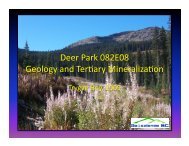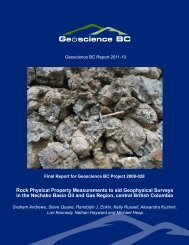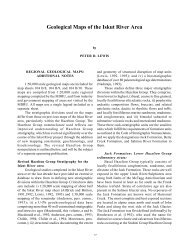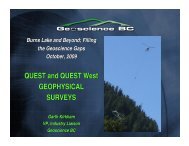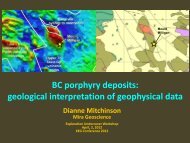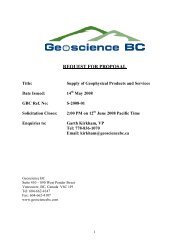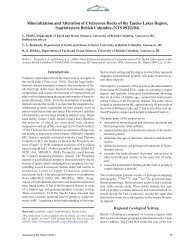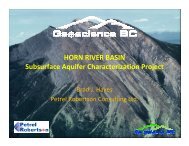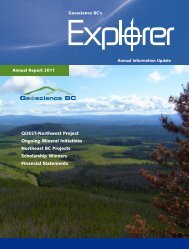Final Report - Geoscience BC
Final Report - Geoscience BC
Final Report - Geoscience BC
You also want an ePaper? Increase the reach of your titles
YUMPU automatically turns print PDFs into web optimized ePapers that Google loves.
3. Project Data3.1. Data DistributionRPDS currently houses 881,064 physical rock property records from borehole wireline, boreholedrillcore and surface sample data within British Columbia. Physical properties measured inboreholes include: density, magnetic susceptibility, conductivity, resistivity, density count,gamma ray count, IP, total field magnetics, spectral gamma-gamma ratio, SP, SP Gradient,single point resistivity, temperature, and temperature gradient. All data have been entered intoRPDS and meta-classifications, unit conversions, and coordinate system conversions have beenapplied, as well as general data quality assessment and control. The following sections describethe datasets in more detail. Tables 1a, 1b, and 1c summarize the <strong>BC</strong> data in RPDS. The spatialdistribution of data collected from <strong>BC</strong> and entered into RPDS is shown in Figure 1.3.1.1. Wireline DataBorehole wireline data (Figure 1, open circles) from 23 holes consisting of 198 logging runs,logged from 1986-1994, were provided by the Borehole Geophysics Group at the GeologicalSurvey of Canada in Ottawa. Mira <strong>Geoscience</strong> traveled to Ottawa to collect the digital andhardcopy data archived on multiple DVDs and over 150 hand-written field logging sheets.Multiple DVDs were copied from GSC archives, which contained various ascii-text filestransferred from original logging tapes. These ascii-text files contained raw and processed dataper logging run and, where available, lithology files per borehole. Logging run metadata werephotocopied from original hardcopy logging field sheets which provided critical informationpertaining to the logging runs as well as for deciphering raw data file names in order to associatethe appropriate raw data with processed data files. Additional metadata was acquired fromsupplementary hardcopy documents, open file reports, and personal communication with GSCcontributors. Where available, hole trace and assay files were generated manually from hardcopycorelogs and paper maps were digitized to pdf format. <strong>Final</strong>ly, data and metadata were formattedto RPDS import standards and entered into the system. This formatting involved applyinggeological and quality indicator classifications, performing unit and coordinate conversions, andminor data quality control. Due to the multiple sources of information, a significant amount ofwork was required to prepare the data for entry into RPDS. An additional 8 holes logged by the4





